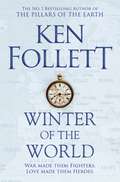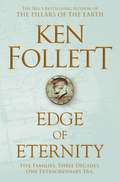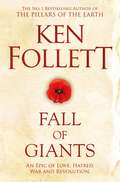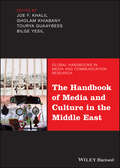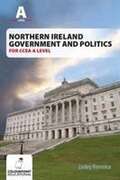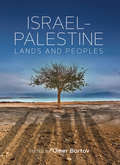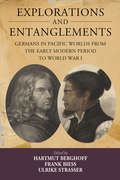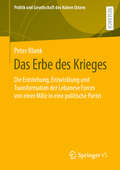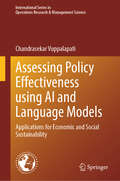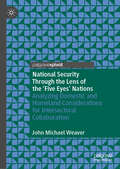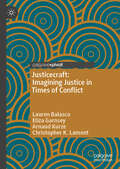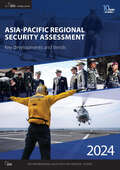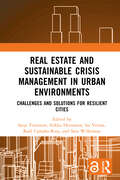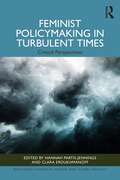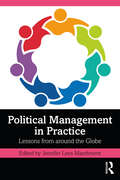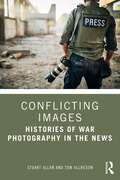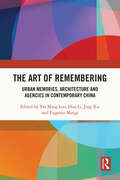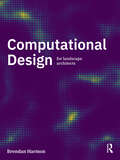- Table View
- List View
Winter of the World (The Century Trilogy #2)
by Ken FollettWinter of the World is the second novel in Ken Follett's uniquely ambitious Century trilogy. On its own or read in sequence with Fall of Giants and Edge of Eternity, this is a spellbinding epic of global conflict and personal drama during World War II.A Battle of IdealsIt is 1933 and, at Cambridge, Lloyd Williams is drawn to irresistible socialite Daisy Peshkov, who represents everything that his left-wing family despise. But Daisy is more interested in aristocratic Boy Fitzherbert, a leader in the British Union of Fascists.An Evil UprisingBerlin is in turmoil. Eleven-year-old Carla von Ulrich struggles to understand the tensions disrupting her family as Hitler strengthens his grip on Germany. Many are resolved to oppose Hitler’s brutal regime – but are they willing to betray their country?A Global Conflict on a Scale Never Seen BeforeShaken by the tyranny and the prospect of war, the lives of five families become ever more enmeshed. As an international clash of military power and personal beliefs sweeps the world, what will this new war mean for those who must live through it?Continue the captivating Century Trilogy with Edge of Eternity.
Edge of Eternity (The Century Trilogy #3)
by Ken FollettEdge of Eternity is the epic, final novel in Ken Follett's captivating and hugely ambitious Century trilogy. On its own or read in sequence with Fall of Giants and Winter of the World, this is an irresistible and spellbinding epic about the fight for personal freedom set during the Cold War.A Fight Against Injustice1961, and in the United States George Jakes, a bright young lawyer in the Kennedy administration and fierce supporter of the civil rights movement, boards a Greyhound bus in Washington with Verena, an employee of Martin Luther King whom he is in love with, to protest against segregation.A Rising Tide of DangerIn East Germany, teacher Rebecca Hoffmann finds her entire life has been a lie as she is targeted by the secret police, even as her younger brother, Walli, dreams of escape across the Berlin Wall to Britain. In Russia, activist Tania Dvorkin narrowly evades capture for producing an illegal news-sheet, her actions all the more perilous because her brother, Dimka, is an emerging star of the Communist Party.A Cold War That Could Eliminate the World ForeverIn a sweeping tale that began in 1911, the descendants of five families will now find their true destiny as they fight for their individual freedom in a world facing the mightiest clash of superpowers it has ever seen.
Fall of Giants: Enhanced Edition (The Century Trilogy #1)
by Ken FollettThe first in Ken Follett's breathtaking Century Trilogy, Fall of Giants is a captivating novel that follows five families through the world-shaking dramas of the First World War, the Russian Revolution, and the struggle for votes for women.A World in Chaos1911, a thirteen-year-old boy, Billy Williams, begins working down the mines as George V is crowned king. The escalating arms race between the empire nations will put not only the king but this young boy in grave danger.A Terrible WarBilly’s family is inextricably linked with the Fitzherberts, the aristocratic owners of the coal mine where he works. And when Maud Fitzherbert falls in love with Walter von Ulrich, a spy at the German embassy in London, their destiny also becomes entangled with that of Gus Dewar, an ambitious young aide to Woodrow Wilson, and two orphaned Russian brothers whose plan to emigrate to America falls foul of conscription, revolution and imminent war.A Revolution That Will Change EverythingWhen Russia convulses in bloody revolution and the Great War unfolds, the five families’ futures are entwined forever, love bringing them closer even as conflict takes them further apart. What seeds will be sown for further tragedy in the twentieth century and what role will each play in what is to come?Continue the captivating Century Trilogy with Winter of the World and Edge of Eternity.
The Handbook of Media and Culture in the Middle East (Global Handbooks in Media and Communication Research)
by Bilge Yesil Tourya Guaaybess Joe F. Khalil Gholam KhiabanyThe Handbook of Media and Culture in the Middle East The Handbook of Media and Culture in the Middle East is an invaluable resource for anyone seeking to understand the profound and complex changes shaping the 21st century. With trans-regional contributions from established and emerging scholars, this ground-breaking volume offers conceptual essays and in-depth chapters that present rich analyses grounded in historical and geopolitical contexts, as well as key theory and empirical research. Rather than viewing the Middle East as a monolithic culture, this Handbook examines the diverse and multi-local characteristics of the region’s knowledge production, dynamic media, and rich cultures. It addresses a wide range of topics, including the evolving mainstream and alternative media, competing histories in the region, and pressing socio-economic and media debates. Additionally, the Handbook explores the impact of regional and international politics on Middle Eastern cultures and media. Designed to serve as a foundation for the next era of research in the field, The Handbook of Media and Culture in the Middle East is essential reading for all academics, scholars, and media practitioners. Its comprehensive scope makes it an excellent primary or supplementary textbook for undergraduate or graduate courses in global studies, media and communication, journalism, anthropology, sociology, economics, political science, and history.
Northern Ireland Government And Politics For CCEA AS Level
by Lesley VeronicaThis well-researched text was written specifically to address Unit AS1 of the current CCEA Government and Politics AS Level specification. It covers the Government and Politics of Northern Ireland and has been through a meticulous quality assurance process. It considers the implementation of the Good Friday Agreement, the amendments made in subsequent agreements (St Andrews, Hillsborough and Stormont House) and examines the functions and responsibilities of the Northern Ireland Assembly, the executive and various political parties. Included in the book are tasks, practice essay titles, key terms and concepts, as well as a detailed glossary, index and examination preparation guide. Areas explored include: * The principles, content and implementation of the Good Friday Agreement and the changes made to it by subsequent agreements. * An analysis of the Assembly, including its three main functions (representation, legislation and scrutiny), and its independence from the Executive. * A look at the Executive Office and the Executive as a whole – how it disappointed, how it can determine legislation and policy, the divisions within it, and its ability to function as a power-sharing government. * An evaluation of the Northern Ireland political parties, including their role in government, their respective backgrounds, strategies and policies, and how they have changed since 1998.
Israel-Palestine: Lands and Peoples
by Omer BartovThe conflict between Israel and Palestine has raised a plethora of unanswered questions, generated seemingly irreconcilable narratives, and profoundly transformed the land’s physical and political geography. This volume seeks to provide a deeper understanding of the links between the region that is now known as Israel and Palestine and its peoples—both those that live there as well as those who relate to it as a mental, mythical, or religious landscape. Engaging the perspectives of a multidisciplinary, international group of scholars, it is an urgent collective reflection on the bonds between people and a place, whether real or imagined, tangible as its stones or ephemeral as the hopes and longings it evokes.
Explorations and Entanglements: Germans in Pacific Worlds from the Early Modern Period to World War I (Studies in German History #22)
by Ulrike Strasser Hartmut Berghoff, Frank BiessTraditionally, Germany has been considered a minor player in Pacific history: its presence there was more limited than that of other European nations, and whereas its European rivals established themselves as imperial forces beginning in the early modern era, Germany did not seriously pursue colonialism until the nineteenth century. Yet thanks to recent advances in the field emphasizing transoceanic networks and cultural encounters, it is now possible to develop a more nuanced understanding of the history of Germans in the Pacific. The studies gathered here offer fascinating research into German missionary, commercial, scientific, and imperial activity against the backdrop of the Pacific’s overlapping cultural circuits and complex oceanic transits.
Das Erbe des Krieges: Die Entstehung, Entwicklung und Transformation der Lebanese Forces von einer Miliz in eine politische Partei (Politik und Gesellschaft des Nahen Ostens)
by Peter BlankDas vorliegende Buch untersucht die Entstehung und Entwicklung der Lebanese Forces als Miliz im libanesischen Bürgerkrieg (1975-1990) und ihre Transformation in eine politische Partei nach dem Ende des Krieges bis in die heutige Zeit. Als eine der wichtigsten Parteien des Landes spiegelt die Entwicklung der Lebanese Forces die wechselhafte Geschichte des Libanons seit dem Bürgerkrieg wider. Durch die Untersuchung der Organisationsstrukturen sowie von Mitgliederprofilen und Ideologie werden die Kontinuitäten und Diskontinuitäten der Parteigeschichte in ihrem historischen Kontext sichtbar gemacht und aufgezeigt, wie das Erbe des Krieges die politischen und gesellschaftlichen Entwicklungen des Libanons auch Jahrzehnte nach dem Ende der Gewalt prägt.
Assessing Policy Effectiveness using AI and Language Models: Applications for Economic and Social Sustainability (International Series in Operations Research & Management Science #354)
by Chandrasekar VuppalapatiThis volume uses advanced machine learning techniques to analyze government communication to evaluate policy effectiveness. The book develops policy effectiveness foundation models by cohorting historical budget policies with statistical models which are built on well reputed data sources including economic events, macroeconomic trends, and ratings and commerce terms from international institutions. By signal mining policies to the economic outcome patterns, the book aims to create a rich source of successful policy insights in terms of their effectiveness in bringing development to the poor and underserved communities to ensure the spread of wealth, social wellbeing, and standard of living to the common denomination of society rather than a selected quotient. Enabling academics and practitioners across disciplines to develop applications for effective policy interventions, this volume will be of interest to a wide audience including software engineers, data scientists, social scientists, economists, and agriculture practitioners.
National Security Through the Lens of the ‘Five Eyes’ Nations: Analyzing Domestic and Homeland Considerations for Intersectoral Collaboration
by John Michael WeaverThis book analyzes the ‘Five Eyes’ nations’ concerns and policies relating to national security threats through an interdisciplinary theoretical engagement with the Political, Information, Security and Economic (PISE) Model. Through the analysis of secondary data sources such as scholarly and government reports, policy documents, press releases and interviews, the author analyzes the five case studies—Australia, Canada, New Zealand, UK, and the USA—to determine how and why nations use the PISE variables to shape favorable homeland security outcomes, to determine what the points of homeland intersectoral collaboration are among the ‘Five Eyes’ nations. In so doing, Weaver determines that although the ‘Five Eyes’ countries have concerns about homeland security and each, individually, identifies threats and hazards, they do also employ collaborative measures to build resilience and increase efforts to prepare for anticipated security breaches.
Justicecraft: Imagining Justice in Times of Conflict
by Christopher K. Lamont Eliza Garnsey Arnaud Kurze Lauren BalascoThis book is about the making of justice. Despite the growing scholarship on transitional and transformative justice, contested struggles for justice in times of political change fail to get the nuanced attention we think they deserve. It seeks to understand how the making of justice is a craft and how this process of craft making is itself a source of political change. The authors introduce a new and novel conceptual framework of justicecraft which sheds light upon political change by unpacking five key elements—the skills, knowledge, labor, affect, and materiality—involved in contested struggles for justice. Justicecraft illuminates the stories and struggles for justice, enabling a greater understanding of accompanying social, political, and cultural shifts in society which unfold during times of conflict. By framing justice as craft, the authors offer a more fluid understanding of how people are producing justice on the ground—and identify the means, the instruments, the language, and claims involved in the process. Each chapter applies the framework of justicecraft to diverse global case illustrations of struggles against past, present, and future injustices and wrongdoings and draws out the key elements embedded in these processes.
Asia-Pacific Regional Security Assessment 2024: Key developments and trends
The Asia-Pacific Regional Security Assessment (APRSA) examines key regional security policies and challenges relevant to the proceedings of the IISS Shangri-La Dialogue, Asia’s premier defence summit convened by the International Institute for Strategic Studies (IISS). It is published and launched at the Dialogue and the issues analysed within its covers are central to discussions at the event and beyond. This eleventh edition comes as the APRSA celebrates its first decade. A dozen IISS experts reflect on a decade of change and continuity across major security policies and challenges facing the Asia-Pacific region. Three themes materialise across six chapters: the pressure and constraints surrounding great-power competition, the enduring value of alliances and partnerships and the impact of advanced and emerging technology for regional security dynamics.In addition to the introduction, the APRSA will now feature a special-topic chapter providing a deeper analysis of an enduring security policy and challenge. The other five chapters investigate further key dimensions of the regional security environment, supported by maps, graphs, charts and tables. The six chapters of this year’s APRSA cover the following topics: Combined military exercises in the Asia-Pacific Crisis management between the United States and China India’s defence partnership in the Asia-Pacific Diplomatic approaches to managing the Myanmar conflict Disinformation campaigns in the Asia-Pacific The Asia-Pacific air-to-air challenge
Asia-Pacific Regional Security Assessment 2024: Key developments and trends
The Asia-Pacific Regional Security Assessment (APRSA) examines key regional security policies and challenges relevant to the proceedings of the IISS Shangri-La Dialogue, Asia’s premier defence summit convened by the International Institute for Strategic Studies (IISS). It is published and launched at the Dialogue and the issues analysed within its covers are central to discussions at the event and beyond. This eleventh edition comes as the APRSA celebrates its first decade. A dozen IISS experts reflect on a decade of change and continuity across major security policies and challenges facing the Asia-Pacific region. Three themes materialise across six chapters: the pressure and constraints surrounding great-power competition, the enduring value of alliances and partnerships and the impact of advanced and emerging technology for regional security dynamics.In addition to the introduction, the APRSA will now feature a special-topic chapter providing a deeper analysis of an enduring security policy and challenge. The other five chapters investigate further key dimensions of the regional security environment, supported by maps, graphs, charts and tables. The six chapters of this year’s APRSA cover the following topics: Combined military exercises in the Asia-Pacific Crisis management between the United States and China India’s defence partnership in the Asia-Pacific Diplomatic approaches to managing the Myanmar conflict Disinformation campaigns in the Asia-Pacific The Asia-Pacific air-to-air challenge
Real Estate and Sustainable Crisis Management in Urban Environments: Challenges and solutions for resilient cities
by Sara Wilkinson Saija Toivonen Sirkka Heinonen Ira Verma Raúl Castaño-RosaThe aim of this book is to promote the dynamic resilience of societies by identifying, analysing, and exemplifying the role of space and land use in both anticipated and unanticipated primary and secondary crisis situations. The book brings together the expertise of a unique team of researchers and methods from fields of futures studies, land use planning, social sustainability and wellbeing, architecture, spatial planning, design and real estate economics, and presents a novel understanding of the direct and indirect impacts of possible crises in the space and land use context. It goes on to discuss the concept of resilience and exemplifies potential solutions and offers a holistic and forward-looking approach for crisis management through a lens of social sustainability and wellbeing, making an important contribution to the promotion of wellbeing in the built environment, especially in terms of land and residential space and building use. This book does not only identify barriers and successful incentives in resilient crisis management but also discusses the role of different stakeholders (e.g., households, office workers, real estate owners, space occupants, firms, the public sector, etc.) in crisis management. Finally, international case studies aiming to tackle the challenging landscape of future threats are presented, along with novel tools to support the development of future policies, regulations, and management practices in the built environment, which can increase the dynamic resilience of societies. Overall, this book is essential reading for decision-makers in the public and private sectors, urban developers, space and spatial designers, architects, planners, community stakeholders, real estate investors, facility managers and crisis and corporate responsibility managers.
Real Estate and Sustainable Crisis Management in Urban Environments: Challenges and solutions for resilient cities
by Sara Wilkinson Saija Toivonen Sirkka Heinonen Ira Verma Raúl Castaño-RosaThe aim of this book is to promote the dynamic resilience of societies by identifying, analysing, and exemplifying the role of space and land use in both anticipated and unanticipated primary and secondary crisis situations. The book brings together the expertise of a unique team of researchers and methods from fields of futures studies, land use planning, social sustainability and wellbeing, architecture, spatial planning, design and real estate economics, and presents a novel understanding of the direct and indirect impacts of possible crises in the space and land use context. It goes on to discuss the concept of resilience and exemplifies potential solutions and offers a holistic and forward-looking approach for crisis management through a lens of social sustainability and wellbeing, making an important contribution to the promotion of wellbeing in the built environment, especially in terms of land and residential space and building use. This book does not only identify barriers and successful incentives in resilient crisis management but also discusses the role of different stakeholders (e.g., households, office workers, real estate owners, space occupants, firms, the public sector, etc.) in crisis management. Finally, international case studies aiming to tackle the challenging landscape of future threats are presented, along with novel tools to support the development of future policies, regulations, and management practices in the built environment, which can increase the dynamic resilience of societies. Overall, this book is essential reading for decision-makers in the public and private sectors, urban developers, space and spatial designers, architects, planners, community stakeholders, real estate investors, facility managers and crisis and corporate responsibility managers.
Feminist Policymaking in Turbulent Times: Critical Perspectives (Routledge Studies in Gender and Global Politics)
Feminist Policymaking in Turbulent Times offers a unique and timely reflection of the critical debates around the institutionalisation of feminist and gender-focused ideas and norms into policy.Many states and non-governmental organisations are increasingly invested in ‘feminist policymaking’ at the domestic and international levels. Yet, this liberal (feminist) agenda is also vastly disputed by critical, intersectional, and decolonial voices on the one hand, and by anti-gender movements around the world on the other hand. Indeed, while opposition to ‘gender ideology’ is mounting from reactionary, religious, and secular forces, feminist policymaking is also being challenged in important ways from within. Thus, this book situates feminist policymaking in a challenging and ‘turbulent’ global context. This book explores feminist policymaking in multiple areas of policy, examining various gender-focused programmes that states and international organisations have undertaken in the last decade, offering critical interventions and rethinking the relationship between feminism and policy. This book not only reflects on the advances of feminist policymaking globally but also critically assesses the intersectional challenges embedded within it and lying ahead. It moves the field forward by creating opportunities, based on lived experiences, for re-imagining the transformative potential of the nexus between feminism and policymaking. Interdisciplinary in scope and bringing to the fore the voices of both academics and practitioners, this book is the product of an international collaboration, forging links and dialogue that are increasingly necessary to question some of the exclusionary, militaristic, and hierarchical assumptions of policymaking which is labelled as feminist.Feminist Policymaking in Turbulent Times will be of interest to all scholars, students, and practitioners interested in the role of gender in policymaking and concerned with contestations around gender-focused projects.
Feminist Policymaking in Turbulent Times: Critical Perspectives (Routledge Studies in Gender and Global Politics)
by Clara Eroukhmanoff Hannah Partis-JenningsFeminist Policymaking in Turbulent Times offers a unique and timely reflection of the critical debates around the institutionalisation of feminist and gender-focused ideas and norms into policy.Many states and non-governmental organisations are increasingly invested in ‘feminist policymaking’ at the domestic and international levels. Yet, this liberal (feminist) agenda is also vastly disputed by critical, intersectional, and decolonial voices on the one hand, and by anti-gender movements around the world on the other hand. Indeed, while opposition to ‘gender ideology’ is mounting from reactionary, religious, and secular forces, feminist policymaking is also being challenged in important ways from within. Thus, this book situates feminist policymaking in a challenging and ‘turbulent’ global context. This book explores feminist policymaking in multiple areas of policy, examining various gender-focused programmes that states and international organisations have undertaken in the last decade, offering critical interventions and rethinking the relationship between feminism and policy. This book not only reflects on the advances of feminist policymaking globally but also critically assesses the intersectional challenges embedded within it and lying ahead. It moves the field forward by creating opportunities, based on lived experiences, for re-imagining the transformative potential of the nexus between feminism and policymaking. Interdisciplinary in scope and bringing to the fore the voices of both academics and practitioners, this book is the product of an international collaboration, forging links and dialogue that are increasingly necessary to question some of the exclusionary, militaristic, and hierarchical assumptions of policymaking which is labelled as feminist.Feminist Policymaking in Turbulent Times will be of interest to all scholars, students, and practitioners interested in the role of gender in policymaking and concerned with contestations around gender-focused projects.
Political Management in Practice: Lessons from around the Globe
by Jennifer Lees-MarshmentAll organisations manage people, and politics is no different. Campaigns, parties, and government all need to manage people and resources to try to get things done. Of course, the extent to which politics is managed effectively is debatable. Recently public awareness of problematic HR in parliaments and government has grown as media reports of problems emerge. Such problematic practice is not surprising given that orientation and training of political practitioners by parties and parliament is hindered by a lack of academic research.This comprehensive volume lays out and builds upon core theoretical foundations in the field of political management, offering a wide range of in-depth empirical research with multiple authors and chapters from different disciplinary perspectives and countries. With authors from political management programmes, political marketing, management, political psychology, and public administration, the book seeks not just to survey a topic or existing literature, but to stimulate research in the area.This book will be highly useful for graduate students, researchers, and professionals in a variety of areas including political management, political marketing, applied politics, political science, management, political psychology, and public administration.
Political Management in Practice: Lessons from around the Globe
by Jennifer Lees-MarshmentAll organisations manage people, and politics is no different. Campaigns, parties, and government all need to manage people and resources to try to get things done. Of course, the extent to which politics is managed effectively is debatable. Recently public awareness of problematic HR in parliaments and government has grown as media reports of problems emerge. Such problematic practice is not surprising given that orientation and training of political practitioners by parties and parliament is hindered by a lack of academic research.This comprehensive volume lays out and builds upon core theoretical foundations in the field of political management, offering a wide range of in-depth empirical research with multiple authors and chapters from different disciplinary perspectives and countries. With authors from political management programmes, political marketing, management, political psychology, and public administration, the book seeks not just to survey a topic or existing literature, but to stimulate research in the area.This book will be highly useful for graduate students, researchers, and professionals in a variety of areas including political management, political marketing, applied politics, political science, management, political psychology, and public administration.
Conflicting Images: Histories of War Photography in the News
by Stuart Allan Tom AllbesonIn contrast with historical examinations centring the evolving role of the war correspondent, Conflicting Images focuses on the contribution of photographers and photojournalists, providing an evaluative appraisal of war photography in the news and its development from the nineteenth century to the twenty-first century.Stuart Allan and Tom Allbeson critically explore diverse genres of war photography across a broad historical sweep, encompassing events from the Crimean War (1853–56) and the Civil War in the United States (1861–65) up to and including conflicts unfolding in Syria and Ukraine. This book reflects on the relevance of different types of warfare to visual reporting, from colonial conquest via trench warfare and aerial bombardment, to the ideological dimensions of the Cold War, and ‘embedding’ and ‘winning hearts and minds’ during the ‘War on Terror’ and its aftermath. In pinpointing illustrative examples, the authors examine changing dynamics of production, dissemination, and public engagement. Readers will come to understand how current efforts to rethink the future of war photography in a digital age can benefit from a close and careful consideration of war photography’s origins, early development, and gradual, uneven transformation over the years. Conflicting Images aims to invigorate ongoing enquires and inspire new, alternative trajectories for future research and practice.This book is recommended reading for researchers and advanced students of visual journalism and conflict reporting.
The Art of Remembering: Urban Memories, Architecture and Agencies in Contemporary China
by Hua Li Jing Xie Yat Ming Loo Eugenio MangiFocusing on the non-Western context and case studies, this book explores theories of interdisciplinary architectural thinking and the construction of urban memory in Chinese cities, with an emphasis on contemporary architecture and the diversity of agencies.China has undergone one of the fastest urbanisation and urban renewal processes in human history, but discussions of urban memory in China have tended to be practice-oriented and lack theoretical reflection. This book brings together interdisciplinary architectural scholarship to interrogate the production of urban memory and examine experiences in China. The 14 chapters explore different processes, projects, materials, architecture and urban spaces in different Chinese cities by analysing cityscapes such as temples, bridges, conservation projects, architectural design, historical architecture, memorial hall, market street, city images, custom bike, food market and so on. The book deals with different agencies and methods, tangible and intangible, in the construction of memories aimed at promoting hybridised multiple identities, and explores the interplay of different versions of memory, i.e. state, public, regional, local, individual and collective memory.This book will be essential reading for scholars and students of architecture and urbanism, cultural studies and China studies, as well as architects, urban planners and historians interested in these fields.
The Art of Remembering: Urban Memories, Architecture and Agencies in Contemporary China
by Hua Li Jing Xie Yat Ming Loo Eugenio MangiFocusing on the non-Western context and case studies, this book explores theories of interdisciplinary architectural thinking and the construction of urban memory in Chinese cities, with an emphasis on contemporary architecture and the diversity of agencies.China has undergone one of the fastest urbanisation and urban renewal processes in human history, but discussions of urban memory in China have tended to be practice-oriented and lack theoretical reflection. This book brings together interdisciplinary architectural scholarship to interrogate the production of urban memory and examine experiences in China. The 14 chapters explore different processes, projects, materials, architecture and urban spaces in different Chinese cities by analysing cityscapes such as temples, bridges, conservation projects, architectural design, historical architecture, memorial hall, market street, city images, custom bike, food market and so on. The book deals with different agencies and methods, tangible and intangible, in the construction of memories aimed at promoting hybridised multiple identities, and explores the interplay of different versions of memory, i.e. state, public, regional, local, individual and collective memory.This book will be essential reading for scholars and students of architecture and urbanism, cultural studies and China studies, as well as architects, urban planners and historians interested in these fields.
Conflicting Images: Histories of War Photography in the News
by Stuart Allan Tom AllbesonIn contrast with historical examinations centring the evolving role of the war correspondent, Conflicting Images focuses on the contribution of photographers and photojournalists, providing an evaluative appraisal of war photography in the news and its development from the nineteenth century to the twenty-first century.Stuart Allan and Tom Allbeson critically explore diverse genres of war photography across a broad historical sweep, encompassing events from the Crimean War (1853–56) and the Civil War in the United States (1861–65) up to and including conflicts unfolding in Syria and Ukraine. This book reflects on the relevance of different types of warfare to visual reporting, from colonial conquest via trench warfare and aerial bombardment, to the ideological dimensions of the Cold War, and ‘embedding’ and ‘winning hearts and minds’ during the ‘War on Terror’ and its aftermath. In pinpointing illustrative examples, the authors examine changing dynamics of production, dissemination, and public engagement. Readers will come to understand how current efforts to rethink the future of war photography in a digital age can benefit from a close and careful consideration of war photography’s origins, early development, and gradual, uneven transformation over the years. Conflicting Images aims to invigorate ongoing enquires and inspire new, alternative trajectories for future research and practice.This book is recommended reading for researchers and advanced students of visual journalism and conflict reporting.
Computational Design for Landscape Architects
by Brendan HarmonThis book is a guide to computational design for landscape architects replete with extensive tutorials. It introduces algorithmic approaches for modeling and designing landscapes. The aim of this book is to use algorithms to understand and design landscape as a generative system, i.e. to harness the processes that shape landscape to generate new forms. An algorithmic approach to design is gently introduced through visual programming with Grasshopper, before more advanced methods are taught in Python, a high-level programming language. Topics covered include parametric design, randomness and noise, waves and attractors, lidar, drone photogrammetry, point cloud modeling, terrain modeling, earthworks, digital fabrication, and more. The chapters include sections on theory, methods, and either visual programming or scripting. Online resources for the book include code and datasets so that readers can easily follow along and try out the methods presented. This book is a much-needed guide, both theoretical and practical, on computational design for students, educators, and practitioners of landscape architecture.
Computational Design for Landscape Architects
by Brendan HarmonThis book is a guide to computational design for landscape architects replete with extensive tutorials. It introduces algorithmic approaches for modeling and designing landscapes. The aim of this book is to use algorithms to understand and design landscape as a generative system, i.e. to harness the processes that shape landscape to generate new forms. An algorithmic approach to design is gently introduced through visual programming with Grasshopper, before more advanced methods are taught in Python, a high-level programming language. Topics covered include parametric design, randomness and noise, waves and attractors, lidar, drone photogrammetry, point cloud modeling, terrain modeling, earthworks, digital fabrication, and more. The chapters include sections on theory, methods, and either visual programming or scripting. Online resources for the book include code and datasets so that readers can easily follow along and try out the methods presented. This book is a much-needed guide, both theoretical and practical, on computational design for students, educators, and practitioners of landscape architecture.
